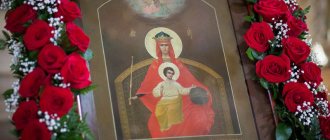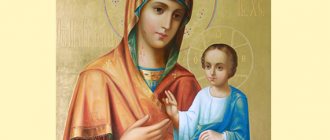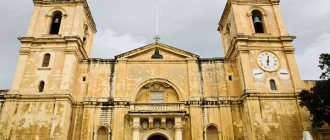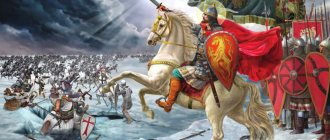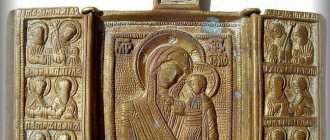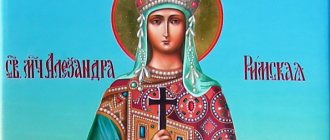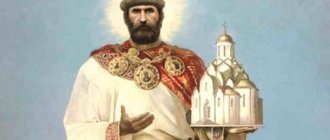The Virgin Mary, who gave the world the Savior, is revered and loved by Christians no less than Jesus. The Mother of God is a symbol of purity, devoted and selfless love, sacrifice and kindness. Followers of other religions treat her with great respect. After all, the infallible Virgo is a kind of standard of a mother who, under any circumstances, remains close to her son, always continues to love and support him.
The Bible does not contain a detailed description of the appearance of the Virgin Mary. It is known that she was a young girl from Nazareth when she was married to the already mature Joseph. After the birth of Jesus, contemporaries saw the Mother of God before them, and therefore, as a rule, they idealized her, considering her incredibly beautiful, exuding light and wisdom.
Today, around the world, millions of icons, frescoes, wall paintings and statues depict the Blessed Virgin. But her images created by sculptors and artists, although they have common features, are too different and do not allow us to form an unambiguous opinion about the real appearance of the Virgin Mary. Sometimes the Mother of God appears to living people to convey important news or strengthen faith. In these cases, living witnesses appear who can tell what she looks like.
Astral projection: truth or myth? Mediums explain the phenomenon of leaving the body
Bringing the rose bush back to life after winter: how to properly reanimate flowers
The craftswoman showed how she uses egg trays (and there’s no shame in giving them as a gift)
Mexican miracle
In December 1531, in the vicinity of Mexico City, the Virgin Mary unexpectedly appeared to the Indian Juan Diego, who had been baptized by Catholic missionaries several years earlier. Juan was walking to church when he heard an enchanting voice coming from the nearby Tepeyac Hill. The curious Indian climbed the hill and saw a beautiful dark woman shrouded in a shining cloud.
She called herself the Mother of God from Guadeloupe and asked to build a temple on this site where her son would be praised. Juan Diego accurately conveyed the words of the Virgin to the priests, but they did not believe him, considering the appearance of the Blessed Virgin before an ordinary Indian incredible.
Time passed, and the Virgin Mary called Diego again. She asked him to collect flowers from the hillside, wrap them in a cloak and take them to the bishop. The puzzled man understood that it was impossible to find flowers in December, but did not argue. To his surprise, he quickly found fresh roses and, as ordered, took them to the priests.
When the Indian unfolded his cloak in front of the skeptical bishop and priests, everyone was amazed to see the face of the Mother of God appearing on the fabric and believed Juan’s words. A temple appeared on Tepeyac Hill. After this miracle, millions of Indians converted to the Christian faith, and the image of the Virgin Mary of Guadalupe is still sacredly revered in Latin America.
The Image of the Mother of God: a history of veneration
In Orthodoxy, images of the Blessed Virgin Mary are especially revered, many of which are miraculous. Not only in churches, but also in the homes of every Orthodox family there is an icon of the Mother of God.
“When a person kisses holy icons with reverence and ardent love, he, as it were, absorbs, absorbs (into himself) the colors of these icons, and in himself, inside, these saints are depicted. The saints rejoice, “tearing themselves away” from papers and boards and imprinting themselves on human hearts. When a Christian reverently kisses holy images and asks for help from Christ, from the Mother of God, from the saints, then he performs a kiss with his heart, which absorbs not only the Grace of Christ, the Mother of God or the saints, but all of Christ or the Most Holy Theotokos or the saints, which stand in the iconostasis of its (inner) temple. "Man is the temple of the Holy Spirit." Look, every service begins and ends with the kissing of icons” (Elder Paisiy Svyatogorets, 1924-1994).
Icon of the Mother of God against the background of the temple
According to legend, the Evangelist Luke painted the first icon of the Mother of God during the earthly life of the Blessed Virgin. The initial veneration of the images of the Mother of God began in the lands of Palestine, associated with the life of the Savior and His Mother.
Some of the oldest images of the Mother of God that have survived to this day are the images found in the Roman underground catacombs (2-3 century). Since the 4th century, the iconography of the Mother of God has developed widely, first in Byzantium and the Balkans, and after the 10th century - in Rus'.
Glass from Absam
An equally striking apparition of the Mother of God occurred in January 1797 in the small village of Absam, located on the outskirts of Innsbruck, Austria. Rosina Buecher, an eighteen-year-old girl, was sewing in her parents' house when she felt someone's attentive gaze on her. Rosina looked out the window and saw a woman’s face on the glass.
Disinfecting wipes are easy to make at home. They are economical and no less effective
Tested for generations: we make effective fertilizing for seedlings
Imaginary threats: why getting close to another person is stressful
The frightened girl decided that she was imagining a face, so she quickly called her mother, who also saw an inexplicable image on the glass. Not knowing whether this was divine providence or the machinations of evil spirits, the women invited neighbors and the local priest. Everyone agreed that the image of the Most Pure Mother of God appeared on the window.
This opinion was further strengthened when glass, given by the Buecher family to the parish church, began to heal worshipers. Thousands of people began to flock to Abzam to bow before the face of the Mother of God, praise her and make requests to her. The amazing glass has survived to this day and is the main attraction of Abzam.
Shepherdess and Virgin Mary
An ordinary fourteen-year-old shepherdess Bernadette from the town of Lourdes became known throughout France after Our Lady appeared to her eighteen times. The first time this happened was on February 11, 1858, when the girl went to buy firewood. Having fallen behind the other children, she suddenly saw an incredibly beautiful woman appear from a cave near a stream, standing on a golden cloud and calling herself the Mother of God.
At first they did not believe the girl, but then she told her confessor the content of her conversations with the Virgin Mary. The priest realized that the illiterate shepherdess simply could not come up with something like this on her own. People came from all over the area to look at Bernadette, chosen by the Mother of God. Later, the girl became a nun, and in 1933 she was canonized as a Catholic saint.
The most famous icons of the Virgin Mary with names
In the Athos monasteries there are many miraculous icons of the Mother of God. They are revered far beyond the boundaries of the Mother of God. The Dochiar Monastery houses the image of the Mother of God “Quick to Hear”, venerated since the 17th century. The careless monk Nil, passing by this icon, smoked the face of the Most Holy Theotokos with a burning torch. When he became blind as punishment, it was only after fervent prayer to the Mother of God that he received healing. The very name of the icon “Quick to Hear” testifies to the ambulance of the Mother of God to believers.
The Iveron Icon of the Mother of God, called the “Goalkeeper,” enjoys special veneration. In the 9th century, she sailed by sea to the shores of Mount Athos. This image is associated with repeated assistance in protecting the Iversky Monastery from enemy attack. There is a legend that in recent times the Iveron Icon will leave Holy Mount Athos. This will be an instruction for the monks to leave this place.
The icon “Recovery of the Lost” is associated with the story “On the repentance of Theophilus, the steward of the church in the city of Adana” (6th century). Having received forgiveness of grave sins after praying to this image of the Mother of God, Theophilus called Her “Recovery of the Lost.” There is a lot of information about the help of the Mother of God through this miraculous image. Thus, in the 17th century in the Kaluga province, after a prayer service, the cholera epidemic stopped.
In the 14th century, the “Three-Handed” icon appeared in the Athos monastery of Hilandar. Serbian Christians, fearing desecration of the image during a Turkish attack, tied the icon to the back of a donkey. The animal independently came to the monastery gates. At the bottom of the image is a human hand (the third), which does not belong to the Virgin Mary. It was a gift from the adviser to the ruler of Damascus (Syria). The adviser's hand was cut off on false charges. After praying in front of the image of the Mother of God, the hand grew together. The “Three-Handed” icon more than once saved the Hilandar monastery from forest fires (1945, 1947).
In the 16th century, the icon of the Mother of God “All-Tsarina” was brought to the Simonapetra Monastery (Athos). Its name testifies to the prayer power of the Mother of God, emanating from Her special closeness to the Son and extending to all Christians. Through prayers in front of this image, believers receive healing for cancer.
Floating Virgin Mary in Egypt
This apparition of the Virgin Mary stands apart. The fact is that it was repeated periodically for quite a long time, from April 1968 to August 1969. Representatives of all religions and even atheists saw it. The Virgin Mary was not only seen, but also photographed.
It all happened in Zeitoun, a suburb of Cairo. Muslims working near a Christian church noticed a female figure hovering near the church peak. Her facial features were impossible to see due to the bright light that came from the woman. But when the men suggested that they were seeing the Virgin Mary, she nodded to them, confirming that they were right.
The news of the miracle quickly spread, and soon tens of thousands of believers of all faiths came to the church to see the Virgin Mary. She appeared in different guises: now bowed near the cross, now with a baby in her arms, now grieving for the whole world. At first, the Mother of God appeared two or three times a week, but gradually she pleased believers and tourists less and less, and in August 1969 she was seen in the sky above the temple for the last time.
Found a violation? Report content
LiveInternetLiveInternet
Quote from Dmitry_Shvarts message
Read in full In your quotation book or community!
Bright face
The bright holiday of Christmas, the holiday of faith, hope and love. A holiday of light in the soul of each of us, which has come to us with her on this day for more than 2000 years. The Virgin Mary, the Blessed Virgin, the Mother of God, Mariam, the Queen of Heaven, Seide Mariam - this is how different people address her in different countries. When we see her, turn to her, this light becomes larger. It is the bright faces of the Mother of God that make up the majority of healing and miraculous icons. People turned to her during great disasters, wars, epidemics, and fires. Legends about cases of miraculous deliverance are included in the History of the Russian state.
Dozens of types of her images - more than 800 - were created over many centuries, based on historical events, reflect the special place of the Mother of God in Christian culture. There is little information left about her, but it is she who we see in the most important events, but which one? According to various sources, there are 4 to 6 main types of icons of the Mother of God, the rest are called editions - that is, variants of the main images.
Oranta (Praying)
This is how the first Christians depicted her - in the form of a prayer address: from the front, to the waist and with raised arms, bent at the elbows, and against the background of the sphere of the Savior Emmanuel.
Icons of this type are also called Panagia ( all-holy) , and in Russia this image is called the Sign in memory of the storming of besieged Novgorod in 1169, when, according to legend, tears flowed from the image of the Virgin Mary pierced by an arrow.
The image of the Mother of God praying with Jesus Christ is the most common in Orthodox iconography. The most famous images of the Sign are Abalakskaya, Narva, Tsarskoye Selo, Kursk-Root. A special place is occupied by the miraculous icon of the Mother of God, the Inexhaustible Chalice , where Christ is depicted in a golden cup. This icon became known to many after the publication of I. S. Shmelev’s story “The Inexhaustible Chalice” (1918).
Hodegetria (Guidebook)
The images of Hodegetria are strict and straightforward, the Mother of God holds the Child Christ on her left hand, pointing at him with her right, their heads do not touch each other. Hodegetria is the oldest type of image of the Virgin Mary, which dates back to the first icon painter in history, Apostle Luke. Here she appears as a guide to God and eternal salvation.
In Russia, the most famous variants of Hodegetria include: Smolenskaya, Iverskaya (Goalkeeper), Tikhvinskaya, Jerusalemskaya, Three-Handed, Passionate, Sporuchnitsa of Sinners.
Eleusa (Tenderness)
The images of the Mother of God belonging to the Eleus are full of tenderness and tenderness, earthly and heavenly, divine and human love. The Child Christ rests his left cheek on the right cheek of the Mother of God, the Mother of God presses her Son to Her.
In the Greek version, this type of icon is called Glykofilus. The sweet kiss is one of the miraculous images, also related to Tenderness, written, according to legend, by the Evangelist Luke. The most touching of the miraculous icons is the Head of Mary bowed to the Son, and He puts his hand around the Mother’s neck. She knows what suffering awaits him. Our Lady of Tenderness is one of the most mystical types of Mother of God icons. This also includes other icons of amazing beauty and power - the Don, the Leaping of the Baby, the Mammal, and the Recovering of the Dead.
The Vladimir Icon of the Mother of God has become the most revered in Russia; it is the one that can most often be seen in wedding couples along with the image of the Savior. It is the image of Tenderness that finds the greatest appeal in a person’s heart, because the idea of sacrificial service, the pain and sorrow of a mother has always been close and understandable in Rus'.
Icons of the Tenderness include: Vladimir, Volokolamsk, Don, Fedorov, Zhirovitsk, Recovery of the Dead, Pochaev.
Panahranta (All-Merciful)
On icons of this type, the Mother of God is depicted sitting on a throne, holding. On her lap she holds the Christ Child. The throne here serves as a symbol of the glory of the Mother of God, as the most perfect one born on Earth.
In Russia, the most famous are Sovereign and Vsetsaritsa .
Agiosortissa (Intercessor)
On icons of this type, the Mother of God is depicted in full height, without the Child, facing to the right, sometimes with a scroll in her hand.
Other icons, in which the Mother of God is depicted alone, can be classified as one of the main types, for example Ostrobramskaya - to the Sign, as well as the Unbrided Bride (it is sometimes called Tenderness, this is the cell icon of St. Seraphim of Sarov), or to the category of Akathist . glorifying her. This, for example, is one of the most revered icons - the Mother of God of Seven Arrows or the Softening of Evil Hearts.
Any icon painting type is not a set of unconditional rules that must be followed, but a direction of thought and a goal that the icon painter strives to achieve. Therefore, each image is unique, although quite recognizable in its dogmatic content and artistic solution.
During childbirth, Helper, Spreader of Bread, Kozelshchanskaya, Healer, Tenderness
It is customary to depict the Mother of God in clothes of two colors: cherry maforia (or blue like Theophanes the Greek), a blue tunic and a blue veil. Three golden stars are depicted on the maforia - as a sign of her purity and a border as a sign of her glorification. Maforium (dress of a married woman) - means Her Motherhood, covered by the blue or blue color of the dress - Virginity. And when painting the image of the Mother of God, they never use black, the color of sorrow, because she is light and hope.
The iconography of the Virgin Mary is a huge part of our culture. Many of her images can be called young, for example, Derzhavnaya was found in 1917, hidden in the basement of a church, and it was painted at the end of the 19th century. Each of the hundreds of famous icons of the Mother of God has its own symbolism and meaning, its own history...
Galina Zamyslova
